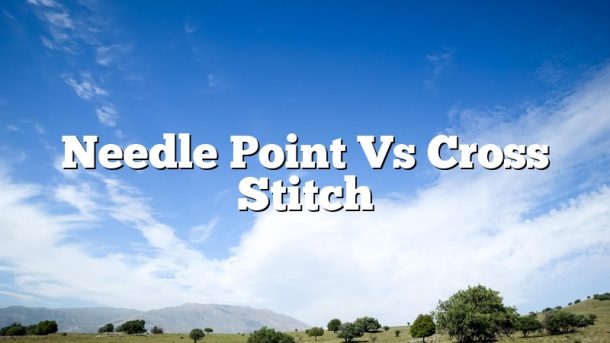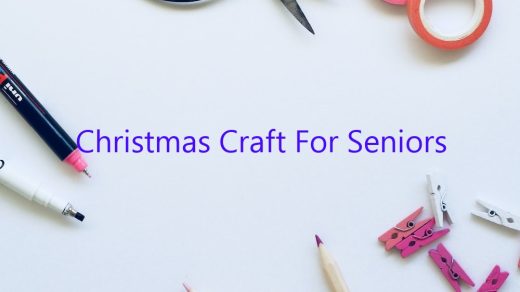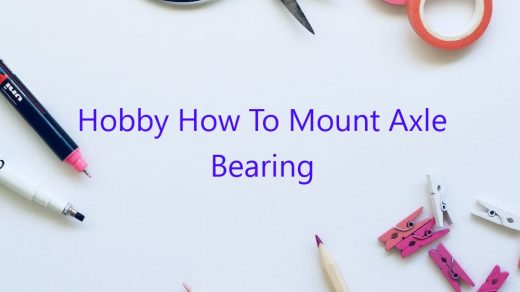There are two types of stitching most commonly used by embroiderers: needlepoint and cross stitch. Both techniques have their own unique advantages, so it can be difficult to decide which one to use for a particular project.
Needlepoint is a type of counted thread embroidery in which each stitch is made up of one or more yarns that are threaded onto a needle. The needle is then inserted into the fabric, and the yarns are pulled through, leaving a loop on the back of the fabric. The loops are then cut, leaving a small knot on the back of the fabric.
Needlepoint is a very versatile type of embroidery. It can be used to create both geometric and free-form designs, and it can be worked in a variety of different stitches, including cross stitch, tent stitch, and continental stitch. It is also very durable, and can be used to create projects that will be washed and used often.
Cross stitch is a type of counted thread embroidery in which each stitch is made up of one or more crosses. Each cross is made up of two stitches: a vertical stitch and a horizontal stitch. The vertical stitch is inserted into the fabric, and the horizontal stitch is then worked over the top of it.
Cross stitch is a very popular type of embroidery, and it can be used to create a variety of different designs, including geometric designs, animal designs, and floral designs. It is also very durable, and can be used to create projects that will be washed and used often.
Contents [hide]
Which is easier needlepoint or cross stitch?
People often wonder which is the easier type of embroidery – needlepoint or cross stitch. The answer is that both stitches have their own unique challenges, and it ultimately depends on what you’re most comfortable with.
Needlepoint is a popular choice for beginners because the fabric is sturdy and the stitches are big and easy to see. It’s generally worked on a mesh canvas, and the yarn is pulled through the mesh to create the stitches. This makes it a relatively fast and easy process, and it’s a great way to work on large designs.
Cross stitch is a bit more challenging, but the end result is usually a lot more detailed. The fabric is usually Aida cloth, which is a plain woven fabric with grid lines that make it easy to keep track of your stitches. You work by stitching over two threads of the fabric at a time, and each cross stitch is made up of four stitches.
Both stitches have their own devotees, and the best way to decide which is right for you is to try both out. Get a small project in each stitch and see which you prefer. There’s no right or wrong answer – it’s all about what you’re most comfortable with.
Which is better needlepoint or cross stitch?
When it comes to needlepoint or cross stitch, which is better? The answer to this question depends on your own personal preferences.
Needlepoint is a type of embroidery that uses a single needle and a solid piece of thread. Cross stitch, on the other hand, uses a cross-shaped needle and a piece of thread that has been divided into four strands.
Needlepoint is often considered to be a more difficult type of embroidery to learn, while cross stitch is considered to be easier. However, some people find needlepoint to be more tedious, while others find cross stitch to be more monotonous.
Ultimately, the choice between needlepoint and cross stitch is a personal one. If you are new to embroidery, we recommend trying out both stitches to see which one you prefer.
How can you tell needlepoint from cross stitch?
There are several ways to tell needlepoint from cross stitch, but the easiest way is to look at the back of the fabric. Cross stitch fabric will have a diamond pattern, while needlepoint fabric will have a woven-looking pattern.
Another way to tell the difference is by the size of the stitches. Cross stitch stitches are usually smaller than needlepoint stitches.
The final way to tell the difference is by the type of thread used. Cross stitch thread is usually thicker than needlepoint thread.
What’s difference between embroidery cross stitch and needlepoint?
Embroidery is a form of needlework that uses thread to embellish fabric. There are many different types of embroidery, but the most common are cross stitch and needlepoint.
Cross stitch is a popular form of embroidery that is done by stitching small squares of fabric in a grid pattern. A piece of cross stitch embroidery is usually made up of many small squares, which are then stitched together to create a larger design. The thread is usually worked over two fabric threads, and the stitches are usually small and relatively evenly spaced.
Needlepoint is a type of embroidery that is done by stitching yarn onto a piece of fabric. Unlike cross stitch, needlepoint does not use squares, and the stitches are usually much larger. Needlepoint is often used to create detailed designs, and the finished piece can be quite intricate.
Is cross stitching good for the brain?
There are many different types of stitching and embroidery and one of the oldest is cross stitching. Cross stitching is believed to have originated in the Middle East and then spread to Europe in the Early Middle Ages. It is a popular hobby today, with many people enjoying it for the relaxation it provides. But is cross stitching good for the brain?
There is some evidence that suggests that cross stitching can be beneficial for the brain. A study published in the journal Human Factors in 2012 found that cross stitching can improve cognitive function. The study found that participants who cross stitched had better performance on tasks that involved attention, focus, and working memory.
Another study, published in the journal Neuropsychology in 2016, found that cross stitching can improve mental flexibility. The study found that participants who cross stitched were better at switching between tasks and inhibiting irrelevant information.
So, what is it about cross stitching that seems to be beneficial for the brain? One possible explanation is that cross stitching requires a lot of focus and attention. It is a complex task that involves following a pattern and paying attention to detail. This type of focus and concentration can help to improve cognitive function.
Mental flexibility is also important for problem solving and creativity, so the fact that cross stitching can improve this ability is also beneficial. The fact that cross stitching is a social activity can also be beneficial, as it can help to increase social interaction and encourage communication.
So, overall, there is evidence to suggest that cross stitching can be beneficial for the brain. It can help to improve cognitive function and mental flexibility. It is a complex task that requires focus and attention, and it can also be a social activity that encourages communication.
Do you use a hoop for needlepoint?
Do you use a hoop for needlepoint?
There are a few different ways to hold your needlepoint canvas while you’re working on it, and using a hoop is one of them.
A hoop is a round or oval shaped frame that you put your canvas in. It helps to keep the canvas tight and in place while you’re stitching, which can be helpful if your hands tend to shake a lot or if you’re working on a large project.
There are a few different types of hoops available. Wooden hoops are the most common type, and they’re usually made from a variety of different woods like bamboo, ebony, or rosewood. Plastic hoops are also common, and they’re often cheaper than wooden hoops. There are also magnetic hoops available, which can be helpful if you’re working on a project that’s a lot of detail.
Some people find that using a hoop helps them to stitch more accurately, while others find that it makes it more difficult to move the canvas around. It’s a personal preference, so you’ll just have to try it out and see if it works for you.
Is needlepoint hard to learn?
Is needlepoint hard to learn?
This is a question that a lot of people have when it comes to needlepoint. The answer, however, is not a simple one. It really depends on the person. Some people find needlepoint to be relatively easy to learn, while others find it to be a bit more challenging.
One of the main things that can make needlepoint hard to learn is if a person is not patient. Needlepoint is a slow process, and it can take a while to get the hang of it. If a person is not patient, they may find it to be frustrating and give up.
Another thing that can make needlepoint hard to learn is if a person does not have good hand-eye coordination. Needlepoint involves a lot of precise movements, and if a person does not have good hand-eye coordination, they may find it difficult to do.
Overall, however, needlepoint is not a particularly difficult craft to learn. With a bit of patience and practice, most people should be able to get the hang of it.




